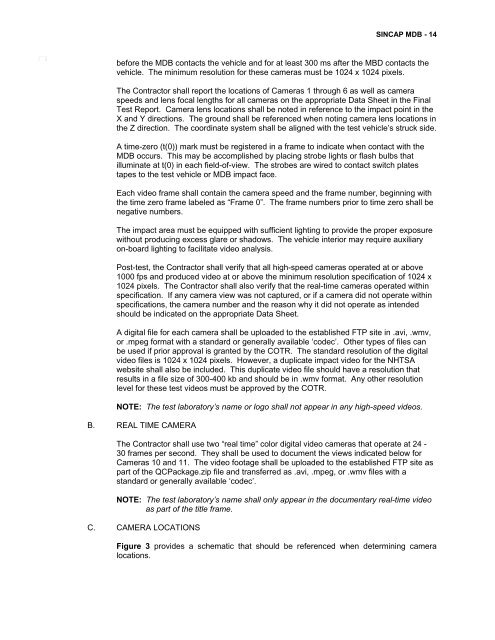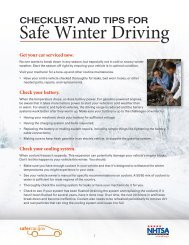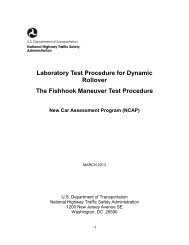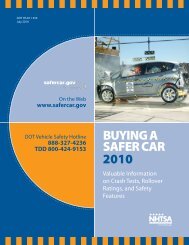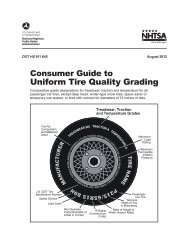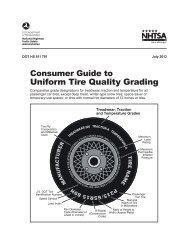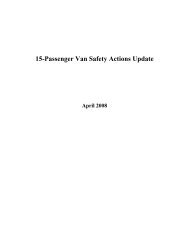U.S. DEPARTMENT OF TRANSPORTATION - SaferCar.gov
U.S. DEPARTMENT OF TRANSPORTATION - SaferCar.gov
U.S. DEPARTMENT OF TRANSPORTATION - SaferCar.gov
You also want an ePaper? Increase the reach of your titles
YUMPU automatically turns print PDFs into web optimized ePapers that Google loves.
SINCAP MDB - 14<br />
before the MDB contacts the vehicle and for at least 300 ms after the MBD contacts the<br />
vehicle. The minimum resolution for these cameras must be 1024 x 1024 pixels.<br />
The Contractor shall report the locations of Cameras 1 through 6 as well as camera<br />
speeds and lens focal lengths for all cameras on the appropriate Data Sheet in the Final<br />
Test Report. Camera lens locations shall be noted in reference to the impact point in the<br />
X and Y directions. The ground shall be referenced when noting camera lens locations in<br />
the Z direction. The coordinate system shall be aligned with the test vehicle’s struck side.<br />
A time-zero (t(0)) mark must be registered in a frame to indicate when contact with the<br />
MDB occurs. This may be accomplished by placing strobe lights or flash bulbs that<br />
illuminate at t(0) in each field-of-view. The strobes are wired to contact switch plates<br />
tapes to the test vehicle or MDB impact face.<br />
Each video frame shall contain the camera speed and the frame number, beginning with<br />
the time zero frame labeled as “Frame 0”. The frame numbers prior to time zero shall be<br />
negative numbers.<br />
The impact area must be equipped with sufficient lighting to provide the proper exposure<br />
without producing excess glare or shadows. The vehicle interior may require auxiliary<br />
on-board lighting to facilitate video analysis.<br />
Post-test, the Contractor shall verify that all high-speed cameras operated at or above<br />
1000 fps and produced video at or above the minimum resolution specification of 1024 x<br />
1024 pixels. The Contractor shall also verify that the real-time cameras operated within<br />
specification. If any camera view was not captured, or if a camera did not operate within<br />
specifications, the camera number and the reason why it did not operate as intended<br />
should be indicated on the appropriate Data Sheet.<br />
A digital file for each camera shall be uploaded to the established FTP site in .avi, .wmv,<br />
or .mpeg format with a standard or generally available ‘codec’. Other types of files can<br />
be used if prior approval is granted by the COTR. The standard resolution of the digital<br />
video files is 1024 x 1024 pixels. However, a duplicate impact video for the NHTSA<br />
website shall also be included. This duplicate video file should have a resolution that<br />
results in a file size of 300-400 kb and should be in .wmv format. Any other resolution<br />
level for these test videos must be approved by the COTR.<br />
NOTE: The test laboratory’s name or logo shall not appear in any high-speed videos.<br />
B. REAL TIME CAMERA<br />
The Contractor shall use two “real time” color digital video cameras that operate at 24 -<br />
30 frames per second. They shall be used to document the views indicated below for<br />
Cameras 10 and 11. The video footage shall be uploaded to the established FTP site as<br />
part of the QCPackage.zip file and transferred as .avi, .mpeg, or .wmv files with a<br />
standard or generally available ‘codec’.<br />
NOTE: The test laboratory’s name shall only appear in the documentary real-time video<br />
as part of the title frame.<br />
C. CAMERA LOCATIONS<br />
Figure 3 provides a schematic that should be referenced when determining camera<br />
locations.


